Apple's 2010 MacBook Air (11 & 13 inch) Thoroughly Reviewed
by Anand Lal Shimpi on October 26, 2010 10:08 PM EST- Posted in
- Mac
- Apple
- MacBook Air
- Laptops
The 11-inch MacBook Air: Faster than the old 13-inch MacBook Air
On paper, the new 13-inch MacBook Air shouldn’t be any faster than the old 2008 MacBook Air - at least in CPU bound tasks. The 2010 model gets a faster GPU but the CPU is literally the same 1.86GHz Core 2 Duo. Memory sizes and speeds haven’t changed either. While the SSD is faster, if you’re running a CPU bound benchmark there shouldn’t be any performance difference. If you assumed the same thing I did, you’d be very wrong.
Take a look at Cinebench 11 comparing the 2008 13-inch MacBook Air to the two 2010 models:
| Cinebench 11 - Multithreaded CPU Benchmark | |||||
| 11-inch MacBook Air (2010) - 1.4GHz Core 2 Duo | 13-inch MacBook Air (2010) - 1.86GHz Core 2 Duo | 13-inch MacBook Air (2008) - 1.86GHz Core 2 Duo | |||
| Cinebench 11 Score (Higher is Better) | 0.81 | 1.1 | 0.70 | ||
Not only is the 2008 13-inch MBA slower than the new 13-inch model, it’s actually slower than the 11-inch model running at 1.4GHz. Something is amiss. Perhaps it’s just this benchmark?
I turned to our Handbrake H.264 encode test to verify my sanity:
| Handbrake 0.94 - H.264 High Profile Transcode | |||||
| 11-inch MacBook Air (2010) - 1.4GHz Core 2 Duo | 13-inch MacBook Air (2010) - 1.86GHz Core 2 Duo | 13-inch MacBook Air (2008) - 1.86GHz Core 2 Duo | |||
| Average Frames per Second (Higher is Better) | 1.14 fps | 1.55 fps | 0.96 fps | ||
Once again, a similar situation. The old MBA is actually slower than the new 11-inch, despite the advantage in CPU speed.
It looks like what we’ve stumbled upon is a combination of Apple aggressively throttling the clock speed of the older MacBook Air CPUs to meet thermal requirements, and the CPUs used in the new MacBook Airs being far better behaved from a voltage/power consumption standpoint.
The 45nm process these Core 2s are built on is as mature as it’s going to get. I’m guessing yield on these parts is as high as can be and as a result, power consumption is probably consistently lower than the original 1.86GHz parts Apple shipped back in 2008. The peak thermal specs themselves haven’t changed, but the actual power characteristics have.
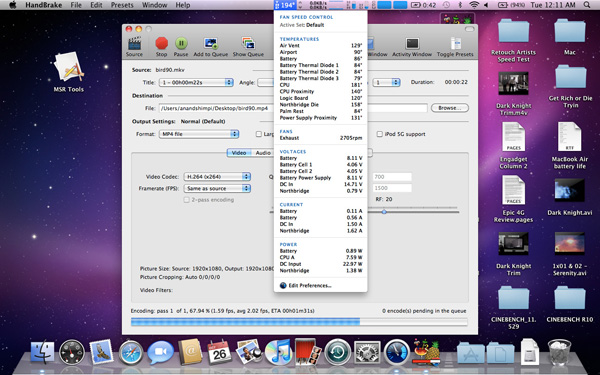
The 2008 MacBook Air under Load
Maximum temperature, at least reported by the MBA’s sensors, isn’t any lower on the new 13-inch than the 2008 I compared it to. Both CPUs hit roughly 84C (183F) under full load. But look at what happens to the chips after a minute at that load:
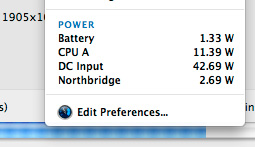 2010 13-inch MacBook Air |
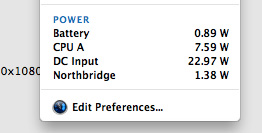 2008 13-inch MacBook Air |
iStat Menus reports the 1.86GHz Core 2 Duo in the 2008 system consuming only 7.59W, while the same CPU in the 2010 machine is drawing 11.45W. The 2008 machine is throttling back to reduce overall temperature while the 2010 system keeps going.
As a result, even the 11-inch MacBook Air will probably end up being as fast, if not faster than the 2nd generation 2008 13-inch MacBook Air. And our performance results confirm that:
| 11-inch MacBook Air (2010) vs. 13-inch MacBook Air (2008) | ||||||||
| Application Launch Test | Adobe Photoshop CS4 | Aperture RAW Import | Cinebench R10 - 1CPU | Cinebench R10 - XCPU | Quicktime H.264 Transcode | |||
| Apple 11-inch MacBook Air (2010) - 1.4GHz Core 2 Duo | 27.8 seconds | 72.4 seconds | 1.29 PPS | 1612 | 2967 | 33.1 fps | ||
| Apple 13-inch MacBook Air (2008) - 1.86GHz Core 2 Duo | 26.4 seconds | 71.3 seconds | 1.20 PPS | 2046 | 2882 | 30.1 fps | ||
You'll notice the less CPU intensive tasks are quicker on the old 13-inch system as the CPU isn't able to get hot enough to trigger Apple's throttling. The single threaded Cinebench test is the best example of this. The 26% performance advantage jibes with the 33% increase in CPU clock speed (it's actually a little low, most likely because the old CPU still isn't running at full speed even in this test). But now look at the heavier tests - the multithreaded Cinebench test and the Quicktime encode. Both of these stress both cores and drive TDP up, which forces Apple to pull clock speed back down. We wondered how Apple was able to cram such a high speed CPU into such a thin chassis as early as it did, now we know.
In practice I found the 2008 13-inch MBA launched applications quicker (short bursts of full clock speed), but after prolonged use or completing CPU intensive tasks it was tough to tell apart from the new 11-inch. What's even more troublesome is that Apple's aggressive clock throttling went relatively undetected until now. This is something I'm going to have to devise tests for and pay more attention to in future reviews. Sneaky, Steve, sneaky.
External Temperatures and Noise
The old MacBook Air chassis had a few dozen slits cut out of the aluminum for ventilation. The new MacBook Air chassis hides the ventilation slits between the base of the unit and the hinge. You can’t see them, but they’re there.
The slits are smaller than they were on the old chassis, which means moving air through them at the same rate sounds louder than before.
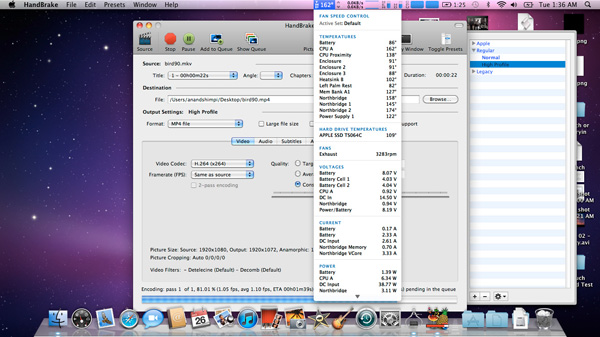
The 11-inch MacBook Air under Load
The CPU in the 11-inch model, even when under heavy loads, likes to stay at or below 72C (162F). At that temperature, the internal fan doesn’t spin above 4000 RPM (usually down below 3400). The 13-inch MacBook Air however is far more likely to generate noise. Running our simple Handbrake test the CPU will peak at over 82C (~180F) and the system’s internal fan will ramp up to over 6K RPM to compensate. Not only does the chassis get hot, but the fan gets audible. It’s still too small of a fan to really be considered loud in the grand scheme of things, but it’s loud enough to be annoying.
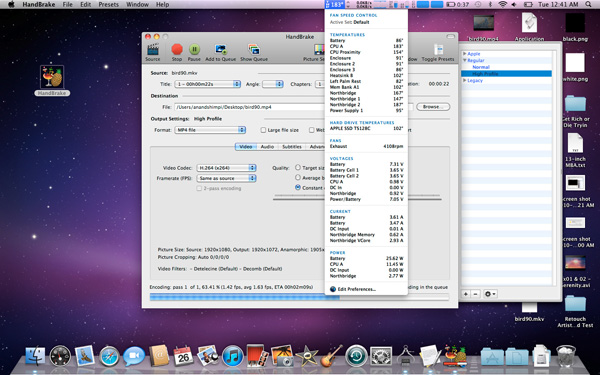
The 13-inch Macbook Air under Load
The surface temperature of the new 13-inch MacBook Air easily gets as high as the 2008 model. I measured a peak of 38.9C (102F) on both the 2008 and 2010 13-inch models. The 11-inch never broke 38C (100F).
Even casual use can ramp up temperatures pretty quickly. Just having a few websites open in the background that use Flash or other CPU intensive elements can slowly cause the MBA’s internal temperatures to rise. And now you’re beginning to see why Apple doesn’t install Flash on these things by default.
The danger zone is the upper left corner of the system, near the hinge. There’s only a single fan that cools both the CPU and GPU in the Air’s very tight enclosure. This is where that fan sits.










185 Comments
View All Comments
Anand Lal Shimpi - Wednesday, October 27, 2010 - link
Not at all. But workloads, even within a given field, have grown much more intense over the past 5 years. While my example was simply photo editing, compile times for large projects should also be much longer on the 11 compared to any of the Core i-series platforms today. I'm not saying it can't be done, I'm saying you'll begin to impact productivity as a result.Obviously what you do for a living is real work - it'd just take longer on the 11-inch MBA vs. one of the MBPs.
Take care,
Anand
lemonadesoda - Thursday, October 28, 2010 - link
I've added a different usage picture for comparison. My "real work" workflow is something like this:1/ Read emails
2/ Read attachments, e.g. word, excel, PDF documents
3/ Take phone calls on VoIP/skype
4/ Log in to corporate webserver, check activity
5/ Send emails
6/ Write offers, workplans, status reports, invoices, in word. Convert to PDF
7/ Review training material/videos incl. created by us on SD card
8/ Fool around on the web during breaks
9/ Check anandtech
10/ Check emails
11/ Prepare articles and presentations, use a beamer (VGA D-SUB)
12/ Online banking
My "real play" workflow is something like this
1/ Read emails
2/ Fool around on the internet
3/ Play a few flash games with my kids
4/ Download pictures from camera on SD card
5/ Check, select, fix, upload to fileserver/website
6/ Download a video from my camcorder
7/ Upload to youtube
8/ Read anandtech
No, I do not expect to use my "netbook" for DirectX gaming. Not sure why everyone wants to do this. Havent they got a full-size desktop for this. A "netbook" has a different life-purpose and shouldnt be expected to replace a desktop.
On an Atom netbook, my workflows struggle with the video material and skype video. Skype audio is OK.
On the Apple 11" the workflows would be fine except we are missing the SD card slot. PITA for me. Not sure how we would connect to a beamer. I guess some kind of "converter dongle" would be needed to get from displayport to D-SUB VGA which is what 99% of beamers (and their room installations) require.
titeroper - Wednesday, October 27, 2010 - link
Anand and gang and fellow forumites - I know I may be shot down for asking this, but perhaps for xmas, can you write a quick article on how you think Apple will deal with Sandy Bridge upgrades early next year for MBP's?How does Nvidia fit in? Is there space for both a dedicated 400m series GPU + Intel HD and Sandy Bridge? Is it as easy as updating the current 2010 config with these parts?
I hope someone can help answer here, as I am looking forward to this update come Q!/Q2 2011.
Pantsu - Wednesday, October 27, 2010 - link
I'll soon update my old white macbook of early 2008, but this isn't quite up to snuff. While the form factor is superb, everything else is not. Weak CPU, only 2GB memory, limited although fast storage, and of course the price. It's probably better to wait for Sandy Bridge or Zacate in early 2011. Those should really bring something new, and I hope Apple will update the MacBook Pro at that time, otherwise I'll have to go Windows again, which I don't care to do in a laptop environment.new-paradigm - Wednesday, October 27, 2010 - link
Just looking at the specs of the 11.6" MBA, and the fact that it's 11.6" ... can apple honestly claim not to be in the netbook game anymore?Seriously, any laptop under 12" in screen size is a netbook, and bizzarely apple's reasoning behind omitting the dvd drive and other sundry pieces of usual hardware/connectivity (i.e. expected use and target audience) is almost exactly the same as those used when explaining their omission on netbboks.
SraCet - Wednesday, October 27, 2010 - link
The term "netbook" was coined to describe the small cheap laptops that were coming out a couple years ago with 7" screens, miniature keyboards, and barely enough storage space to run Linux. NETbook because they were only powerful enough to do basic web surfing--get it?Now everybody is calling every small laptop a "netbook," I guess because the word sounds cool, and everybody has their own made-up criteria for what is and isn't a netbook.
If you want to arbitrarily declare that anything with a < 12" screen is a netbook then fine. But surely you realize this isn't what Steve Jobs was referring to when he expressed his displeasure with "netbooks."
lemonadesoda - Thursday, October 28, 2010 - link
The word "netbook" is a living and evolving term. I don't think it was coined to have a fixed meaning of "cheap and 7 inch" and nothing else! Many years ago a laptop was something that was 11-13". Now we have laptops with 15" and 17" screens. Nobody is shouting "you cant call it a laptop, it doesnt sit on your lap anymore". The term laptop has evolved. Just as has the term desktop. Does desktop have to mean a very expensive Intel 386 with ISA, PCI, floppy and VDU? No, of course not.I think it is better to let the term netbook be defined as a "underspecced compared to a workstation" and "portable enough to put in your briefcase" and "powerful enough to run "net" applications" then I think we can allow the Apple 11" to be called a netbook. It is helping to redefine the term netbook perhaps, just like a mercedes or bmw has redefined our expectations of what a car is, or can be.
webdev50 - Wednesday, October 27, 2010 - link
Unfortunately, reviews like these don't consider how these machines will hold up after you start using them on a daily basis. Apple's equipment is developing a notorious reputation for having quality control issues. Search TS2377 on Google. Apple is using commodity hardware just like other manufacturers do, so Apple's equipment is prone to failure like everyone else's, regardless of price.My 2008 MacBook Pro 17" was repaired twice for the same Nvidia issue within a couple of months this year, so I switched to a Windows 7 machine instead because I need a reliable computer. I still have my MacBook Pro, but I'm running a stress test on it 12 hours a day trying to break it so I can get it replaced from Apple. When I get the replacement, I'm not even going to open the box; just sell it on craigslist.
Sure, OS X is pretty, but what good is it if the hardware is unreliable? And I can't legally use OS X on anything but Apple hardware. (Besides, after using Mac OS X software for 7 years, I've actually found it to be quite limiting and not as robust and mature as Windows software.) I'm not going to buy more than one Mac just so I can have a spare to use while Apple spends weeks repairing my computer.
Dealing with the "Geniuses" at the Apple Store can be very unpleasant too. When I called Apple Tech Support to verify what I was told at the Apple Store, they suggested I go to another Apple Store.
What am I supposed to use when my Mac breaks down and is getting repaired? It's cheaper to buy two Windows machines if one of them needs to be repaired than to buy one Mac.
My perspective now is not to buy anything from Apple that can't be immediately swapped if it's faulty. An iPhone or iPod can be quickly swapped out. Macs need to go through Apple's three-ring circus to get repaired. And who knows what the gorillas in the back room are going to do with it (and the spinning hard drive)? After I got my machine back from them, I needed to clean the lens on the DVD drive so I could burn a backup DVD. I don't want to know what they stuck in my DVD drive.
iwodo - Wednesday, October 27, 2010 - link
Isn't that a known issues that happen on ANY nvidia Gfx Laptop?AMDJunkie - Wednesday, October 27, 2010 - link
iwodo is right. HP, Dell, anyone who used the mobile (and desktop) Nvidia 8600 chip was affected. Research "bumpgate."I think Apple's pretty damn generous to have a program in place to replace your logic board, even out of warranty, seeing as just last month Nvidia finally settled and made a page for owners of PCs with the afflicted chips to get refunds or repairs. If you had an HP, I had heard (hearsay, now), that if you were out of warranty, tough, and this was the only (and only recently available) recourse.
I know for a fact that Apple's not as generous to give you a whole new model though, as long as it's for the graphics issue. Your best bet is to go here:
http://www.nvidiasettlement.com/